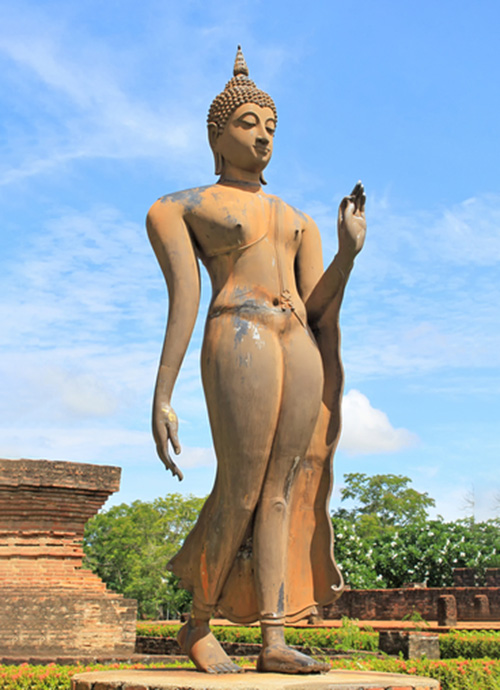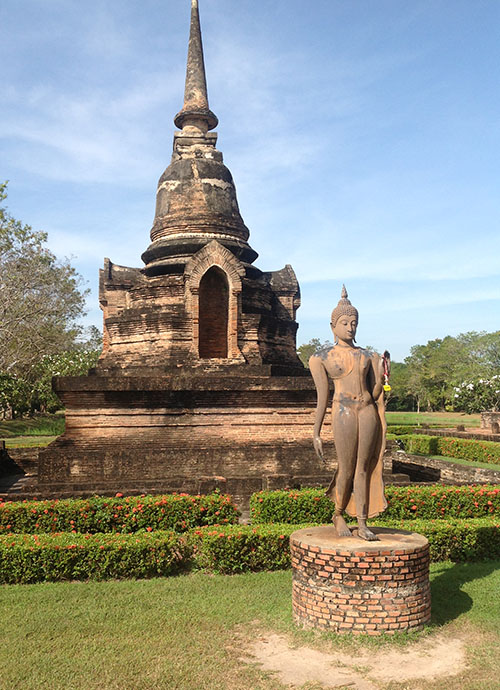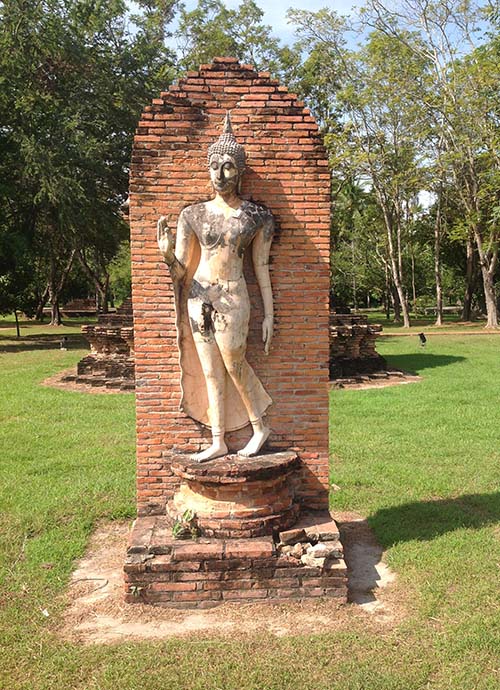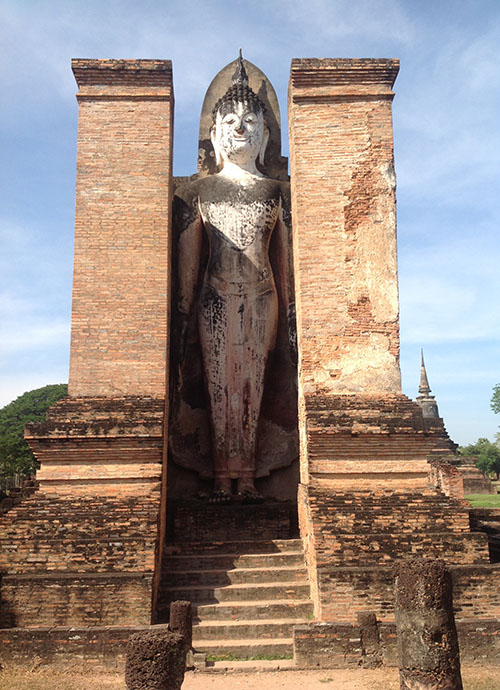
Sukhothai style Buddha images
Sukhothai developed its own distinctive style in temple architecture as well as in the creation of Buddha images, mostly influenced by Singhalese styles. During the Sukhothai era Buddha images were created in the main four postures, namely sitting, standing, walking and reclining.
Sukhothai style Buddha images depict the Buddha after He had reached enlightenment, freed of all that is worldly. Images express serenity, calmness and contentedness and show a hint of a slight smile on the face.
Distinguishing Sukhothai style features
The Sukhothai style images of the Buddha distinguish themselves from other styles like Singhalese, Khmer or Mon by several characteristics: A gracious appearance, finely curled hair, broad shoulders, oval face, absence of hair lines, long ears, thin lips and a slight smile. Some have a flame shaped aureole around the head.
Most Sukhothai style sitting Buddha images are either in the meditation mudra or in the Bhumisparsha mudra, also known as “calling the Earth to witness” or “subduing Mara”.
Most Sukhothai style walking Buddha images show the Vitarka mudra (teaching and discussion) or Abhaya mudra (dispelling fear).

Wat Sa Si
Walking Buddha images
The walking Buddha is unique to the Sukhothai era. The image stands out through its splendor and graceful appearance, the clothing draped loosely around the body, the heel of one foot lifted, the eyes lowered.
The walking Buddha depicts the Buddha’s descend from the Tavatimsa Heaven, where He taught the Buddhist teachings to His mother who had died seven days after the Buddha’s birth and who had reincarnated in Heaven. The walking Buddha also depicts walking as one of the four postures for exercising meditation and the Buddha walking up and down a golden bridge during the third week after reaching enlightenment.
Walking images of the Buddha can be found in several temples including the Wat Sa Si and Wat Tra Phang Ngoen in Sukhothai and the Wat Phra Si Rattana Mahathat Chaliang in Si Satchanalai.

Wat Tra Phang Ngoen
Phra Attharot, large standing images
During the Sukhothai era, many very large images of the Buddha were built, including the large standing images known as Phra Attharot. The images are named after their height; Attharot loosely translates to “measuring nine meters tall”.
The Wat Mahathat in the central zone contains two large standing Buddha images each enshrined in a mondop flanking the main chedi. The Phra Attharot of the Wat Saphan Hin in the West zone overlooks the valley standing on top of a 200 meter high mound.

Wat Mahathat
Four images in different postures enshrined in a mondop
Large images of the Buddha were often enshrined in mondops that were among the most important structures in Sukhothai era temples. Some mondops enshrined four large images of the Buddha in four different postures, namely standing, walking, sitting and reclining, each facing a different direction.
This architectural style was possibly influenced by Bagan. Similar structures are found in the temples of Bagan in Burma, that predate Sukhothai. Examples of this style can be found at the Wat Chetuphon and the Wat Phra Phai Luang in Sukhothai.
Famous Sukhothai style images outside of Sukhothai
Some of the best known and highly revered Sukhothai style Buddha images are found outside of Sukhothai.
The Phra Buddha Chinnarat is regarded one of the most beautiful Buddha images in Thailand. The golden image of the Buddha in the Subduing Mara mudra was cast in 1357. It is enshrined in the Wat Phra Si Rattana Mahathat in Phitsanulok. A copy of the Phra Buddha Chinnarat image is found in one of Bangkok’s best known temples, the Wat Benchamabophit, also known as the marble temple.
Another famous Sukhothai style image is the Golden Buddha of the Wat Traimit in Bangkok, the largest gold Buddha image in the world.
- Wat Mahathat
- Wat Si Sawai
- Wat Sa Si
- Wat Sorasak
- Wat Tra Phang Ngoen
- Wat Si Chum
- Wat Chetuphon
- Wat Phra Phai Luang
- Wat Saphan Hin
- Private or group tour
- Full day tour from Sukhothai
- Explore historical park & countryside by bike
From Chiang Mai
- Private or group tour
- One day or multiple days tour from Chiang Mai
- Explore historical park & countryside by bike